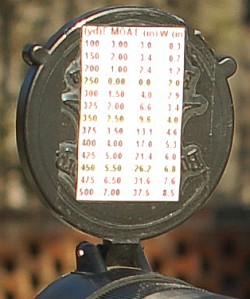Handy Laminated Ballistics Card Helps Hunters & Tactical Shooters
Three-gun match competitor Zak Smith employs a simple, handy means to store his elevation and wind dift data — a laminated data card. To make one, first generate a come-up table, using one of the free online ballistics programs such as JBM Ballistics. You can also put the information in an Excel spreadsheet or MS Word table and print it out. You want to keep it pretty small.
Below is a sample of a data card. For each distance, the card includes drop in inches, drop in MOA, drop in mils. It also shows drift for a 10-mph cross wind, expressed three ways–inches, MOA, and mils. Zak explained that “to save space… I printed data every 50 yards. For an actual data-card, I recommend printing data every 20 or 25 yards.” But Zak also advised that you’ll want to customize the card format to keep things simple: “The sample card has multiple sets of data to be more universal. But if you make your own data card, you can reduce the chance of a mistake by keeping it simple. Because I use scopes with MILS, my own card (photo below left) just has three items: range, wind, drop in MILS only.”


Once you have the card you can fold it in half and then have it laminated at a local office store or Kinko’s. You can keep this in your pocket, tape it to your stock, or tie the laminated card to your rifle. If you regularly shoot at both low and high elevations, you may want to create multiple cards (since your ballistics change with altitude). To learn more about ballistic tables and data cards, check out the excellent “Practical Long-Range Rifle Shooting–Part 1″ article on Zak’s website. This article offers many other insights as well–including valuable tips on caliber and rifle selection.
Scope-Cover Mounted Ballistics Table
 Another option is to place your ballistics card on the back of the front flip-up scope cover. This set-up is used by Forum member Greg C. (aka “Rem40X”). With your ‘come-up’ table on the flip-up cover you can check your windage and elevation drops easily without having to move out of shooting position. Greg tells us: “Placing my trajectory table on the front scope cover has worked well for me for a couple of years and thought I’d share. It’s in plain view and not under my armpit. And the table is far enough away that my aging eyes can read it easily. To apply, just use clear tape on the front objective cover.”
Another option is to place your ballistics card on the back of the front flip-up scope cover. This set-up is used by Forum member Greg C. (aka “Rem40X”). With your ‘come-up’ table on the flip-up cover you can check your windage and elevation drops easily without having to move out of shooting position. Greg tells us: “Placing my trajectory table on the front scope cover has worked well for me for a couple of years and thought I’d share. It’s in plain view and not under my armpit. And the table is far enough away that my aging eyes can read it easily. To apply, just use clear tape on the front objective cover.”
Updated Links for JBM Ballistics Program
With the release of version 5.1 of the JBM program, some URLs for the calculations pages have changed. You may want to update your bookmarks with the following web addresses:
|
JBM Calculations Entry Page: www.jbmballistics.com/ballistics/calculators/calculators.shtml. JBM Advanced Trajectory Calculator: www.jbmballistics.com/cgi-bin/jbmtraj-5.1.cgi. JBM Simple Trajectory Calculator: www.jbmballistics.com/cgi-bin/jbmtraj_simp-5.1.cgi. JBM Trajectory Cards (Come-up Table): http://www.jbmballistics.com/cgi-bin/jbmcard-5.1.cgi. |
Similar Posts:
- Dope for Your Scope — Print Handy Laminated Ballistics Card
- Scope Dope — Make Your Own Laminated Ballistics Card
- How to Make Your Own Laminated Cards with Ballistics Data
- Dope for Your Scope — Handy Laminated Ballistics Card
- Print and Laminate a Ballistics Data Card
Share the post "Handy Laminated Ballistics Card Helps Hunters & Tactical Shooters"
Tags: ballistics, Card, Come-ups, Dope, Drop Table, Laminated Card, Zak Smith


















nice..but a lot of times the “old school” ballistic cards/charts do NO GOOD when current atmospheric conditions change from initial sight-in conditions….I’ll stick to my Droid X and ShooterApp…thank you…
Have fun messing with your PDA in the field under time pressure. It’s always fun to watch guys show up and try to operate a PDA when they have to locate, range, and shoot 6 targets in 5 minutes.
When my data-card system ( http://demigodllc.com/datacards.php ) is used as described in the articles, you set your 100-yard zero and then simply select a card that has a density altitude relatively close to the actual D.A. at the locale/conditions.
It *is* very handy to have a PDA app handy for situations and conditions outside of what you’d want on a card, but for overall speed and efficiency of use in the field, the PDA does not work well.
..I shoot a known-range tactical course.
(4) stations with (4) targets per station
ranges from 275 to 1,165 yards.
on the morning of the shoot, I check my Droid X running ShooterApp, adjust my tables and away I go..
Wow that sounds like very practical training, shooting at 4 known targets at known distances. Very useful and applies perfectly to the real world. Keep up the good work and keep your batteries charged